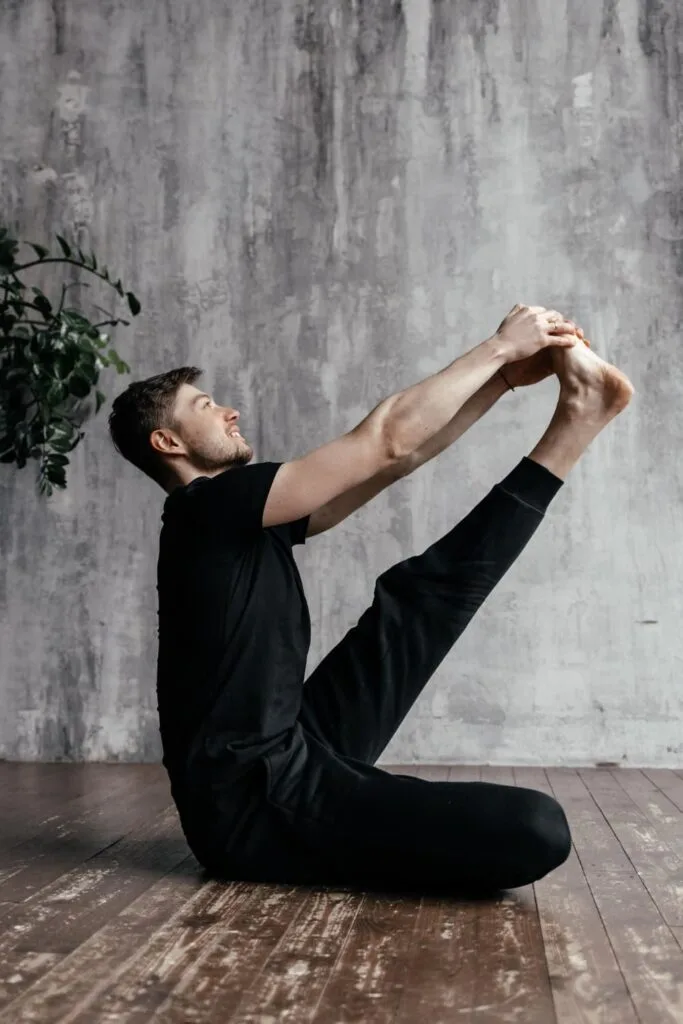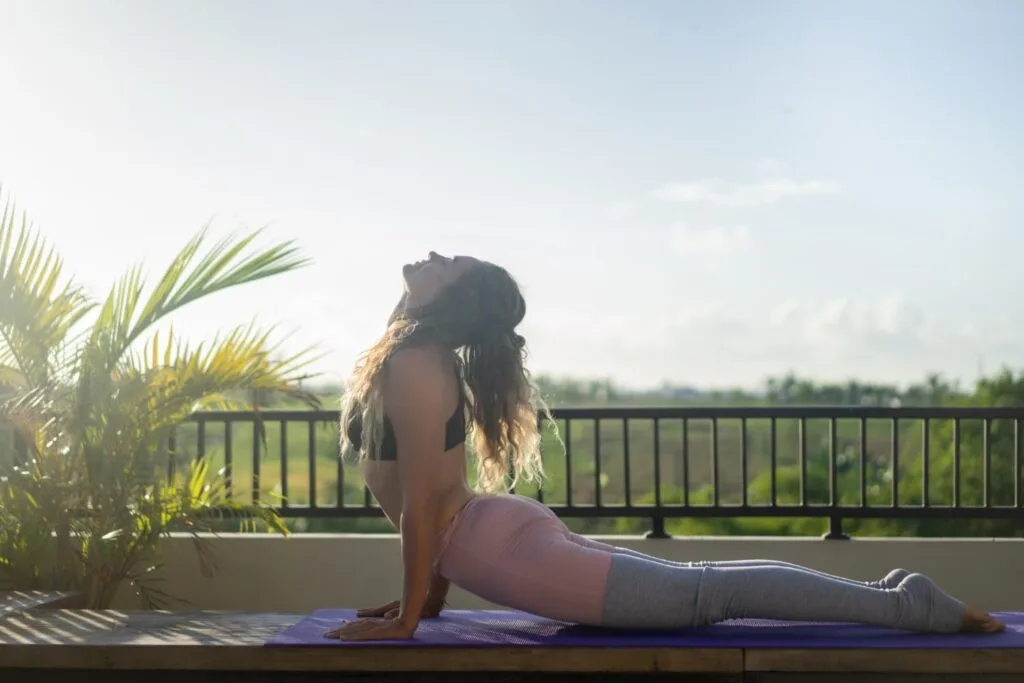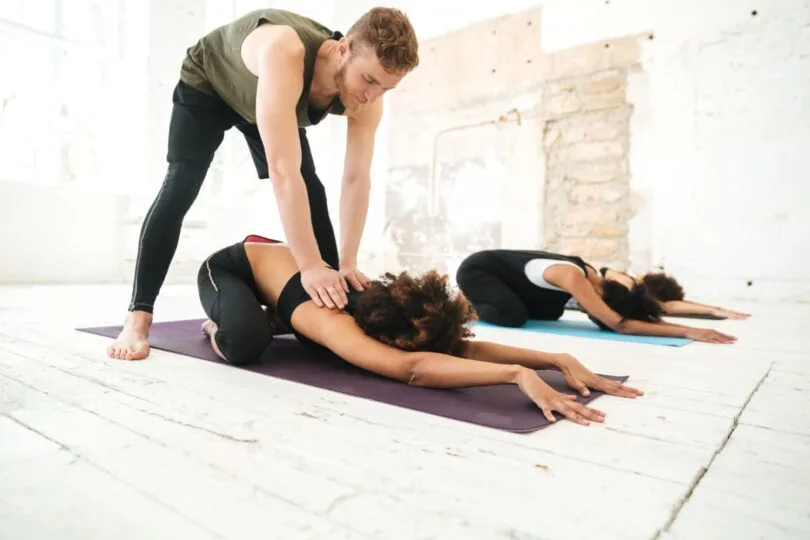Table of Contents
Introduction
Yoga stretches offer a fantastic way to improve flexibility, build strength, and find some peace of mind. Whether you’re a newbie or a seasoned yogi, incorporating these stretches into your routine can transform your physical and mental well-being. In this guide, we’ll walk through the benefits of yoga stretches, how to prepare for them, and the different levels of poses you can try. Let’s get started!
Benefits of Yoga Stretches
Physical Benefits
Yoga stretches are a game-changer when it comes to physical health. For starters, they improve flexibility, which is crucial for overall mobility and injury prevention. By regularly practicing yoga poses, you’ll notice a significant increase in your range of motion. Additionally, yoga stretches enhance muscle strength. Many poses require you to hold your body weight in challenging positions, which builds and tones muscles over time.
Furthermore, yoga stretches to aid in better posture. Many of us spend our days hunched over desks, leading to back pain and poor posture. Yoga poses help to correct this by strengthening the muscles that support the spine, making it easier to stand tall and maintain proper alignment.
Another fantastic physical benefit is improved circulation. Yoga stretches encourage blood flow throughout the body, delivering oxygen and nutrients to tissues and organs more efficiently. This can lead to healthier skin, better digestion, and overall improved vitality.
Mental Benefits
Beyond the physical, yoga stretches offer numerous mental benefits. One of the most notable is stress reduction. Life can be hectic, and stress can take a toll on our mental health. Yoga provides a much-needed break, allowing you to focus on your breath and be present in the moment. This mindfulness practice helps to calm the mind and reduce anxiety.
Additionally, yoga stretches can lead to improved mental clarity. By combining movement with breath control, yoga encourages a state of mental focus and concentration. This can help clear the mind of clutter, making it easier to think clearly and make decisions.
Moreover, regular practice of yoga stretches can promote a sense of inner peace. The meditative aspect of yoga helps to balance emotions and foster a feeling of contentment. This emotional stability can positively impact all areas of your life, from personal relationships to professional endeavors.
Incorporating yoga stretches into your daily routine can transform both your body and mind, leading to a healthier, happier you. In the next section, we’ll discuss how to prepare for yoga stretches to get the most out of your practice.
Preparing for Yoga Stretches
Choosing the Right Environment
Creating the perfect environment for your yoga stretches is key to a successful practice. First and foremost, find a quiet space where you won’t be disturbed. This could be a dedicated room in your home, a corner of your living room, or even a spot in your backyard. The important thing is that it should be free from distractions, allowing you to focus on your practice.
Next, make sure you have a comfortable mat. A good yoga mat provides cushioning for your joints and a non-slip surface for your poses. If you’re practicing on a hard floor, you might also consider using a blanket or towel for extra padding.
It’s also helpful to have some yoga props on hand. Items like blocks, straps, and bolsters can aid in your stretches, especially if you’re a beginner or working on flexibility. If you don’t have these props, don’t worry—household items like books or belts can serve as substitutes.
Warming Up
Warming up before diving into yoga stretches is crucial to prevent injury and get the most out of your practice. A good warm-up prepares your muscles and joints, making them more pliable and ready for stretching.
Start with some light cardio to get your blood flowing. This could be a few minutes of walking, jogging in place, or jumping jacks. The goal is to raise your heart rate slightly and increase circulation throughout your body.
After your light cardio, move into some dynamic stretches. These are active movements that take your joints through their full range of motion. Examples include arm circles, leg swings, and gentle twists. Dynamic stretches help to loosen up your muscles and joints, making them more receptive to the deeper stretches you’ll be doing in your yoga practice.
Remember, the warm-up is not just about preparing your body but also your mind. Take this time to focus on your breath and set an intention for your practice. Whether it’s to gain flexibility, relieve stress, or simply enjoy some quiet time, having a clear intention can make your yoga session more meaningful.
By choosing the right environment and warming up properly, you’ll set the stage for a successful yoga practice. These simple steps can make a big difference in how you feel during and after your stretches. Now that you’re prepared, let’s move on to the basic yoga stretches that are perfect for beginners and seasoned practitioners alike.

Basic Yoga Stretches
Downward Dog Pose
The Downward Dog Pose is a staple in many yoga routines and offers numerous benefits.
Steps to Perform:
- Start on your hands and knees, with your wrists aligned under your shoulders and your knees under your hips.
- Spread your fingers wide and press firmly into the mat.
- Tuck your toes under and lift your knees off the floor, straightening your legs as much as comfortable.
- Push your hips up and back, creating an inverted V shape with your body.
- Keep your head between your arms and gaze towards your feet.
Benefits:
- Stretches the hamstrings, calves, and arches of your feet.
- Strengthens the shoulders, arms, and legs.
- Improves blood flow to the brain, helping with mental clarity.
Cat-Cow Stretch
The Cat-Cow Stretch is perfect for warming up the spine and easing tension in the back.
Steps to Perform:
- Begin on your hands and knees in a tabletop position.
- Inhale, arch your back and let your belly drop towards the mat (Cow Pose).
- Exhale, round your spine towards the ceiling, and tuck your chin to your chest (Cat Pose).
- Continue to flow between these two poses with your breath.
Benefits:
- Increases the flexibility of the spine.
- Stretches the neck, chest, and abdomen.
- Improves posture and balance.
Child’s Pose
Child’s Pose is a restful pose that provides a gentle stretch for the back, hips, and thighs.
Steps to Perform:
- Start on your hands and knees.
- Sit back on your heels and extend your arms forward on the mat.
- Lower your forehead to the ground and relax your entire body.
- Breathe deeply and stay in the pose for as long as you like.
Benefits:
- Relieves tension in the back, shoulders, and chest.
- Calms the mind and reduces stress.
- Gently stretch the hips, thighs, and ankles.
Seated Forward Bend
The Seated Forward Bend is excellent for stretching the entire back of the body, from the calves to the spine.
Steps to Perform:
- Sit on the floor with your legs extended straight in front of you.
- Inhale and lengthen your spine.
- Exhale, hinge at the hips and reach your hands towards your feet.
- If possible, hold your feet or place your hands on your shins or the floor.
- Keep your spine long and avoid rounding your back.
Benefits:
- Stretches the hamstrings, spine, and shoulders.
- Calms the mind and helps with anxiety.
- Improves digestion by stimulating the abdominal organs.
These basic yoga stretches are ideal for anyone starting out or looking to refine their practice. They provide a solid foundation for building flexibility, strength, and relaxation. Now, let’s move on to some intermediate yoga stretches that will challenge your body and mind a bit more.
Intermediate Yoga Stretches
Warrior I Pose
Warrior I Pose is a powerful standing stretch that builds strength and stability.
Steps to Perform:
- Begin in a standing position with your feet hip-width apart.
- Step your left foot back about four feet, keeping your right foot facing forward.
- Turn your left foot slightly outward and bend your right knee to a 90-degree angle.
- Raise your arms overhead, palms facing each other.
- Hold the pose, focusing on your breath and balance.
Benefits:
- Stretches the chest, lungs, and shoulders.
- Strengthens the legs, ankles, and back.
- Improves focus and balance.
Triangle Pose
Triangle Pose offers a deep stretch for the legs and torso while enhancing balance.
Steps to Perform:
- Stand with your feet about three to four feet apart.
- Turn your right foot forward and your left foot slightly inward.
- Extend your arms out to the sides at shoulder height.
- Hinge at your right hip and reach your right hand towards your shin, ankle, or the floor.
- Extend your left arm towards the ceiling, keeping your chest open.
Benefits:
- Stretches the legs, hips, groin, hamstrings, and calves.
- Opens the chest and shoulders.
- Improves digestion and relieves stress.
Bridge Pose
Bridge Pose is great for opening the chest and strengthening the back.
Steps to Perform:
- Lie on your back with your knees bent and feet flat on the floor, hip-width apart.
- Place your arms alongside your body with your palms facing down.
- Press your feet and arms into the floor, lifting your hips towards the ceiling.
- Clasp your hands under your back, if possible, and roll your shoulders under.
- Hold the pose, breathing deeply.
Benefits:
- Stretches the chest, neck, spine, and hips.
- Strengthens the back, glutes, and hamstrings.
- Stimulates the abdominal organs and lungs.
Camel Pose
Camel Pose provides a deep stretch for the front of the body and helps to open the chest and shoulders.
Steps to Perform:
- Kneel on the floor with your knees hip-width apart.
- Place your hands on your lower back with your fingers pointing downward.
- Press your hips forward as you arch your back, reaching for your heels with your hands.
- Keep your neck neutral, or let your head drop back gently.
- Hold the pose, breathing steadily.
Benefits:
- Stretches the entire front of the body.
- Opens the chest, improving respiratory function.
- Strengthens the back muscles and improves posture.
These intermediate yoga stretches offer a deeper challenge for your body and mind. Incorporating them into your routine will build strength, flexibility, and balance. Next, we’ll look at some advanced yoga stretches for those ready to take their practice to the next level.
Related Article: Morning Yoga Routine: Start Your Day with Simple Stretches

Advanced Yoga Stretches
Headstand
Headstand is known as the king of all yoga poses and offers numerous benefits for both body and mind.
Steps to Perform:
- Start in a kneeling position, then place your forearms on the floor, interlocking your fingers.
- Place the top of your head on the floor, cupping the back of your head with your hands.
- Lift your knees off the floor and walk your feet closer to your head.
- Engage your core and gently lift your feet off the ground, straightening your legs towards the ceiling.
- Hold the pose, breathing deeply and steadily.
Benefits:
- Strengthens the shoulders, arms, and core.
- Improves blood circulation to the brain.
- Relieves stress and boosts focus.
Crow Pose
Crow Pose is a challenging arm balance that requires strength and focus.
Steps to Perform:
- Start in a squat with your feet close together and your hands on the floor, shoulder-width apart.
- Bend your elbows and lift your hips, placing your knees on the backs of your upper arms.
- Shift your weight forward onto your hands and lift your feet off the ground.
- Balance on your hands, keeping your gaze forward to maintain balance.
- Hold the pose, engaging your core and breathing deeply.
Benefits:
- Strengthens the arms, wrists, and core.
- Improves balance and concentration.
- Builds confidence and focus.
Firefly Pose
Firefly Pose is an advanced arm balance that stretches the hamstrings and challenges your strength.
Steps to Perform:
- Start in a squat with your feet wide apart and your hands on the floor between your legs.
- Slide your arms underneath your legs, placing your hands on the floor outside your feet.
- Straighten your legs while lifting your hips and balancing on your hands.
- Extend your legs out to the sides, keeping them straight and strong.
- Hold the pose, engaging your core and breathing steadily.
Benefits:
- Stretches the hamstrings and groin.
- Strengthens the arms and core.
- Improves balance and concentration.
Scorpion Pose
Scorpion Pose is a deep backbend and inversion that requires flexibility and strength.
Steps to Perform:
- Start in a forearm stand with your forearms on the floor and your legs lifted towards the ceiling.
- Bend your knees and arch your back, bringing your feet towards your head.
- Engage your core and maintain balance by focusing on a point on the floor.
- Hold the pose, breathing deeply and steadily.
Benefits:
- Stretches the spine and opens the chest.
- Strengthens the shoulders, arms, and core.
- Improves balance and flexibility.
These advanced yoga stretches are perfect for those looking to push their practice further. Incorporating these poses will benefit not only your body but also your mind, leading to greater strength, flexibility, and focus. Now, let’s move on to some tips for getting the most out of your yoga stretches.
Tips for Effective Yoga Stretches
Consistency
One of the most important aspects of practicing yoga stretches is consistency. It’s not about how long you practice in a single session but how regularly you do it. Aim to incorporate yoga stretches into your daily routine. Even if you only have ten minutes, a short, daily practice can yield significant benefits over time. Regular practice helps in building flexibility, strength, and mental clarity.
Listening to Your Body
Always pay attention to your body during your yoga practice. If something doesn’t feel right, ease up or modify the pose. Pain is a signal that something might be wrong, so never push through it. Instead, focus on gentle stretching and improving gradually. Remember, yoga is about finding a balance between effort and ease. Adjust each pose to fit your current flexibility and strength levels.
Breathing Techniques
Proper breathing is essential in yoga. Deep, steady breaths can help you hold poses longer and with more ease. It also aids in relaxing the mind and improving focus. Practice diaphragmatic breathing, where you breathe deeply into your belly rather than shallowly into your chest. This type of breathing supports the parasympathetic nervous system, promoting a state of calm and relaxation.
Use Props
Don’t hesitate to use props like blocks, straps, or blankets. Props can help you get into poses more comfortably and hold them longer. For instance, if you’re struggling with flexibility, a strap can help you reach your feet in seated forward bends. Blocks can provide support in standing poses like Triangle Pose, allowing you to maintain proper alignment without strain.
Warm-Up
Before diving into deeper stretches, always start with a warm-up. This prepares your muscles and joints, reducing the risk of injury. Simple movements like Cat-Cow Stretch, gentle twists, and light cardio can get your blood flowing and muscles ready for more intense stretches. A good warm-up sets the tone for a productive and safe yoga session.
Cool Down
Just as warming up is crucial, so is cooling down. Finish your practice with some gentle stretches and poses that allow your body to relax and your heart rate to return to normal. Poses like Child’s Pose, Seated Forward Bend, and Corpse Pose are excellent for cooling down. This helps in reducing muscle soreness and gives your body time to absorb the benefits of your practice.
Setting an Intention
Setting a clear intention for your practice can make your session more meaningful. Whether it’s to improve flexibility, relieve stress, or simply enjoy some quiet time, having a goal can keep you motivated. An intention provides direction and purpose, helping you stay focused throughout your practice.
Related Article: Flexibility Boost: Yoga Stretches
FAQs About Yoga Stretches
What is the best yoga to stretch?
The best yoga for stretching depends on your goals and level of experience. However, many people find that Hatha Yoga is excellent for stretching. It focuses on basic poses that improve flexibility and strength. Another great option is Yin Yoga, which involves holding poses for longer periods to deeply stretch the muscles and connective tissues.
What is yoga stretching?
Yoga stretching involves performing yoga poses that lengthen and stretch the muscles and connective tissues in your body. These stretches can improve flexibility, increase blood flow, and relieve muscle tension. Yoga stretching combines physical movement with breath control and mindfulness, offering benefits for both the body and mind.
Which yoga is best for flexibility?
Vinyasa Yoga and Yin Yoga are often considered the best for flexibility. Vinyasa involves flowing from one pose to another, which can help to gradually increase your range of motion. Yin Yoga, on the other hand, focuses on deep, passive stretches held for several minutes, which target the connective tissues and joints, significantly improving flexibility over time.
Is it good to do yoga stretches every day?
Yes, doing yoga stretches every day can be very beneficial. Daily practice helps maintain and gradually increase flexibility and strength. It also promotes better posture, reduces stress, and improves overall physical and mental well-being. However, it’s important to listen to your body and not push yourself too hard. Even a short, gentle daily practice can have significant positive effects.







